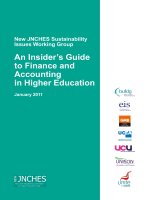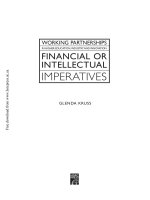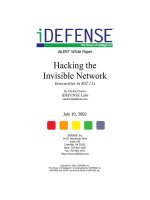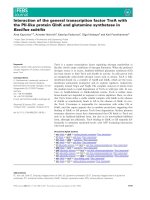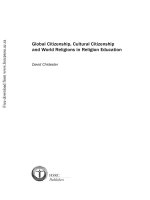IT Security and Academic Values : Computer and Network Security in Higher Education potx
Bạn đang xem bản rút gọn của tài liệu. Xem và tải ngay bản đầy đủ của tài liệu tại đây (81.83 KB, 14 trang )
Copyright 2003 Jossey-Bass Inc.
Published by Jossey-Bass, A Wiley Company. Reprinted by permission of John Wiley &
Sons, Inc. For personal use only. Not for distribution.
Chapter 1
IT Security and Academic Values
Diana Oblinger
Computer and Network Security in
Higher Education
Mark Luker and Rodney Petersen, Editors
A Publication of EDUCAUSE
1
T
he networks and computer systems of colleges and universi-
ties abound with student, medical, and financial records;
institutional intellectual property for both research and education;
and a host of internal and external communications in digital
form that are required for normal operations each and every day.
Compromised computers on campuses have been used to attack
other sites in government and industry. Maintaining a proper level
of security for these digital resources is now a critical requirement
for the institution.
Although educators may agree with the need for security, dif-
ferences of opinion arise when specific practices are proposed. For
example, technology personnel may consider the use of a firewall a
necessary precaution, whereas faculty might see this restriction as
an impediment to intellectual freedom. Logging user access is one
method of tracking intruders; it also can be considered a threat to
privacy. Higher education is faced with the need to apply appropri-
ate security without compromising the fundamental principles of
the academy. As a result, it will be important for colleges and uni-
versities to determine which principles are most relevant and val-
ued by its particular community. Articulation of a common set of
principles may serve as a starting point for campus discussions about
computer and network security.
IT Security and Academic Values
Diana Oblinger
1
01chap.qxd 8/31/03 10:02 AM Page 1
2COMPUTER AND NETWORK SECURITY IN HIGHER EDUCATION
Unique Culture and Environment
Critical aspects of higher education preclude the wholesale adop-
tion of business or government security procedures. The unique mis-
sion of higher education and its role in developing individuals is
one distinctive feature. Another is an operational environment
oftentimes characterized by a transient student population, a resi-
dential environment, and the research enterprise. A third is a
widely held set of core values that shape the environment and
behaviors of the community.
Higher Education’s Mission
Three components are used to describe higher education’s mission:
•
Education. Transmitting, transforming, and extending
knowledge, as well as promoting the intellectual and
moral development of students (Boyer, 1990)
•
Scholarship. Discovering, integrating, evaluating, and
preserving knowledge in all forms (Duderstadt, 2000)
•
Service. Furnishing special expertise to address the
problems and needs of society
As a result, higher education supports a unique combination of
activities that include human development and serving as a custo-
dian and conveyor of culture and civilization. These characteristics
result in a special social contract between higher education and soci-
ety. Education clearly provides more than preparation for a career.
Education is designed to provide social and cultural understanding
for effective citizenship and the development of intellectual capacity
that will allow people to continue learning throughout life.
Higher Education Operational Environment
In some respects, higher education replicates a town or small city.
There are residential environments, green space to preserve, roads and
01chap.qxd 8/31/03 10:02 AM Page 2
parking areas to maintain, buildings to operate, and utilities to be pro-
vided. This environment creates challenges for computer and network
security. For example, students are able to bring their own computer
equipment and connect to the network. The software on those com-
puters can be from a host of vendors representing an array of versions,
and both students and vendors might be unaware of security problems
in those products. The transient nature of the student population
and the adoption of wireless capabilities present further challenges.
Although not entirely unique, the instructional and research
environments of colleges and universities are more pervasive and
open than in government or corporate training departments and
research laboratories. Perhaps as an outgrowth of this environment,
the academic culture tends to favor experimentation, tolerance, and
individual autonomy—all characteristics that make it more difficult
to create a culture of computer and network security.
Higher Education Values
Several core academic values are potentially affected by the need
for increased computer and network security. These include com-
munity, autonomy, privacy, and fairness.
Community
The academic community sees itself not only as a physical place but
as a virtual community, as well as a state of mind. Colleges and uni-
versities view themselves as a community of scholars, instructors,
researchers, students, and staff. The community ideal makes a cam-
pus the locus of learning, thoughtful reflection, and intellectual
stimulation (Duderstadt, 2000).
This ideal influences the community-based governance of higher
education. In shared governance, all relevant parties consult on and
participate in decisions (typically faculty and administrators, but
often other groups are involved as well). This localized decision-
making culture tends to resist attempts by external groups to make
its decisions or dictate policy or process.
IT Security and Academic Values 3
01chap.qxd 8/31/03 10:02 AM Page 3
4COMPUTER AND NETWORK SECURITY IN HIGHER EDUCATION
Although the academic community may seem to be internally
focused, the notion of community is very broadly defined in higher
education. Most institutions see their mission as serving a much
wider community than merely that on campus. As a result, higher
education has strong beliefs about inclusiveness, diversity, equitable
access, international outreach, and support for the local commu-
nity. Higher education accepts a responsibility to reach out with its
knowledge, expertise, and culture to the external community.
Autonomy
Higher education’s strong sense of autonomy may reflect the origins
of U.S. higher education, in which institutions were intentionally
independent of governmental control. Only in the last half century
has public higher education become a dominant force. However,
even in public higher education, institutions have adopted mecha-
nisms (for example, governing boards) to maintain independence
from government (Eaton, 2000).
That strong sense of autonomy is reflected at the faculty level in
values such as academic freedom. Academic freedom embodies the
right to pursue controversial topics, ideas, and lines of research with-
out censorship or prior approval. American higher education stead-
fastly adheres to principles of academic freedom.
A closely related idea, though not synonymous, is that of intel-
lectual freedom. Intellectual freedom provides for free and open
scholarly inquiry, freedom of information, and creative expression,
including the right to express ideas and receive information in the
networked world (Eaton, 2000). One possible interpretation of
intellectual freedom is that individuals have the right to open and
unfiltered access to the Internet.
Building on its history, higher education holds strongly to val-
ues of institutional and faculty autonomy. In such an environment,
uniform standards for computer and network security may be diffi-
cult to reach.
01chap.qxd 8/31/03 10:02 AM Page 4
Privacy
Both U.S. society and higher education place significant value on
privacy. Privacy is essential to the exercise of free speech, free
thought, and free association. The right to privacy has been upheld
based on the Bill of Rights, and many states guarantee privacy in
their constitutions and in statute (American Library Association
[ALA], 2003). Privacy, in the context of the library, is considered
to be “the right to open inquiry without having the subject of one’s
interest examined or scrutinized by others” (ALA, 2002). Privacy
is considered a right of faculty and students.
Higher education depends on fair information practices, includ-
ing giving individuals notice regarding how information about
them will be used. Higher education also guarantees that informa-
tion collected will not be shared without permission. Among the
implications of privacy is that computer and network users should
have the freedom to choose the degree to which personal infor-
mation is monitored, collected, disclosed, and distributed (ALA,
2002). In the context of libraries, borrowing records are kept con-
fidential. In addition, institutions must ensure the privacy of stu-
dent records as well as other information, such as patient records,
to meet federal requirements.
Fairness
Colleges and universities place great value on fair and predictable
treatment of individuals and therefore are invested in defining due
process (ALA, 2003).
1
Because fairness and due process are priori-
ties, higher education defines and relies on public policies and pro-
cedures that guide institutional behavior, even though they are not
always the same as those of the external community. Equal access
to information can also be seen as a logical extension of fairness.
Equal access implies that users have the same access to information
regardless of race, values, gender, culture, ethnic background, or
other factors.
IT Security and Academic Values 5
01chap.qxd 8/31/03 10:02 AM Page 5
6COMPUTER AND NETWORK SECURITY IN HIGHER EDUCATION
It is clear that computer and network security is now essential
to protecting privacy and other academic values. It is just as impor-
tant, however, that measures taken to improve security do not them-
selves compromise these values.
Principles for Implementing Security
in Higher Education
In August 2002, the EDUCAUSE/Internet2 Computer and Net-
work Security Task Force hosted an invitational workshop, spon-
sored by the National Science Foundation, to establish a set of
principles that might guide campus efforts to establish security plans
and policies. The goal of the workshop was to ensure that the artic-
ulation of higher education’s values, particularly those affected by
efforts to improve IT security, would guide colleges and universities
as they decide how to improve the security of computers and net-
works.
2
Six principles were identified that may have implications
on security policies and procedures.
Civility and Community
Civility and community are critical in higher education. As a result,
respect for human dignity, regard for the rights of individuals, and
the furtherance of rational discourse must be at the foundation of
policies and procedures related to computer and network security.
Communities are defined by a set of common values, mutual expe-
riences, shared knowledge, and an ethical framework, as well as a
responsibility and commitment to the common good. A tension
often exists between standards of civility and the right to freedom
of expression.
Colleges and universities should identify reasonable standards
of behavior for the use of institutional networks, computers, and
related infrastructure as well as acceptable standard security prac-
tices and principles to support these core values.
01chap.qxd 8/31/03 10:02 AM Page 6
Academic and Intellectual Freedom
Academic freedom is the cornerstone of U.S. higher education. It
ensures freedom of inquiry, debate, and communication, which are
essential for learning and the pursuit of knowledge. Faculties are
entitled to freedom in classroom discussions, research, and the pub-
lication of those results, as well as freedom of artistic expression. In
addition, individuals are entitled to seek, receive, and impart infor-
mation, express themselves freely, and access content regardless of
the origin, background, or views of those contributing to their cre-
ation. Intellectual freedom ensures information access and use,
which are essential to a free, democratic society.
Although these principles are widely held among the professo-
riat, they may not be well understood by other groups, such as tech-
nology personnel. As a result, all higher education personnel should
be educated to respect academic and intellectual freedom.
Networks and systems must be sufficiently secure to prevent
unauthorized modification of online publications and expression,
but open enough to enable unfettered online publication and
expression. At the same time, colleges and universities, as reposi-
tories of information, must determine the degree to which they will
provide access to other scholars and citizens, as well as to affiliated
students, faculty, and staff.
Privacy and Confidentiality
In the United States, privacy is the right and expectation of all
people and an essential element of the academic environment.
Confidentiality limits access to certain types of information. Con-
fidentiality and protection of privacy are also required to comply
with federal and state law. To the extent possible, the privacy of
users should be preserved. Privacy should be protected in infor-
mation systems, whether personally identifiable information is
provided or derived. Fair information practices should guide the
collection and disclosure of personal information. Higher education
IT Security and Academic Values 7
01chap.qxd 8/31/03 10:02 AM Page 7
8COMPUTER AND NETWORK SECURITY IN HIGHER EDUCATION
must strike an appropriate balance between confidentiality and
use. For example, systems should be designed to enable only
authorized access, while keeping the identity of authorized users
confidential. These systems should respond to the privacy choices
specified by individuals and should be able to implement fair
information practices.
Users should have access to information about system logging
policies and procedures, including how log data are secured, de-
identified or aggregated, and disposed of, as well as information
about who has access to the log data, provided that such infor-
mation does not jeopardize system security. Authentication and
authorization systems that ensure compliance with license agree-
ments should not retain individually identifiable user informa-
tion. In addition, user authentication-authorization logs should
be kept separate from system usage logs, with no linking of the
two data sets.
Equity, Diversity, and Access
Approaches to security and privacy should respect the equity and
diversity goals of higher education by ensuring that access to appro-
priate information and the Internet is provided equitably to all
members of the community. Not everyone interacts with computer
or network-based systems with a common set of technical or per-
sonal resources. Minority-serving institutions, for example, may be
particularly vulnerable to security attacks due to limited resources
or a lack of in-house expertise (AN-MSI Security Committee,
2002). Technology should be used to enable all sectors of the com-
munity to participate in higher education.
Additional system demands imposed for the purposes of com-
puter and network security should not unreasonably inhibit users
whose purposes are legitimate but whose technology resources are
limited. In addition, personal disabilities should be accommodated
through secure systems. Accommodations for various groups of users
should be kept confidential.
01chap.qxd 8/31/03 10:02 AM Page 8
Fairness and Process
Access to computer systems, networks, and scholarly resources is
essential for individual success within the academy. It is also essen-
tial for the delivery of quality services to students, faculty, and staff.
Such access should be provided widely to every member of the
enterprise. Colleges and universities should develop and communi-
cate explicit policies governing the fair and responsible use of com-
puter and network resources by the academic community. All
policies should be accompanied by a description of the process to
be followed when any member of the community violates the estab-
lished policies. Institutions should revoke or limit computer and
network access only as a result of a serious offense and after a
defined process has been followed.
As a result, campuses should support core higher education val-
ues (intellectual freedom, privacy, and civility) and not overreact
to individual reports of abuse. Security policies, guidelines, and prac-
tices should be discussed and reviewed within the context of each
institution’s shared governance system. In the event of abuse, cam-
puses must define due process for each member of the community,
identifying the appropriate policy and office for guidance in han-
dling incidents (copyright policy, campus posting, noncommercial
use, and so forth). Beyond dealing with security breaches, institu-
tions should capitalize on the opportunity a breach represents to
reinforce security messages and provide education so that future
actions support, rather than undermine, security.
Ethics, Integrity, and Responsibility
Computer and network security is a shared responsibility, relying
on the ethics and integrity of the campus community. Respect for
confidentiality and privacy is necessary for the vitality of the com-
munity. The issue of computer and network security provides a tan-
gible opportunity for teaching and modeling acceptable behavior,
as well as reinforcing principles of fair and equitable access to elec-
tronic resources.
IT Security and Academic Values 9
01chap.qxd 8/31/03 10:02 AM Page 9
10 COMPUTER AND NETWORK SECURITY IN HIGHER EDUCATION
Inappropriate individual access or use of information infringes
on the rights and responsibilities of the entire community. All mem-
bers of the academic community share a responsibility for security
because disruption of services restricts the transmission and explo-
ration of knowledge. Ultimately, security based on integrity and
ethics is stronger than security based on technology alone. All
members of the academic community must be held to the same eth-
ical standards.
Selected Security Practices
A wide range of practices can be used to improve computer and net-
work security. Some of these practices have the potential to raise
concerns about their appropriateness for an academic setting. Col-
leges and universities face the challenge of balancing the need for
security and the techniques available with their institutions’ values,
and of discussing the relationships and tradeoffs with a degree of
precision that can lead to acceptable, positive results.
•
Authentication. The use of a user ID and password is among
the most straightforward of security approaches. However, password-
guessing software (available on the Web) makes many passwords
vulnerable. Can or should institutions enforce strict adherence to
procedures, such as changing passwords on a regular basis or using
complex passwords that include symbols, alpha, and numeric char-
acters? If so, does this compromise autonomy?
•
Firewalls. Many organizations use firewalls to limit access to
networks from the public Internet. A firewall prevents outsiders
from accessing internal or private resources. Does this technique
pose an unacceptable limitation on access to higher education?
•
Packet filtering by source. Packet filtering provides a passive
means of security by allowing only packets that come from recog-
nized sources or networks to enter the network. Does such a prac-
tice unnecessarily restrict access?
01chap.qxd 8/31/03 10:02 AM Page 10
• Virtual private network. A virtual private network (VPN)
establishes a secure “tunnel” between the user and the server. VPNs
protect networks from unauthorized access and log user actions.
Does the creation of a VPN unfairly restrict access to higher edu-
cation’s resources?
•
E-mail content filtering. E-mail can transmit sensitive infor-
mation (such as patient or student information) and viruses. Insti-
tutions can install software filters to screen content, preventing
intentional or accidental transmission of sensitive information.
Does content filtering represent an invasion of privacy? Does it
threaten intellectual freedom?
•
Web content filtering. Web content filtering programs allow
organizations to track Web-based activities, such as students down-
loading music or video over the residence hall network. They can
also detect the downloading of malicious code (often done by unsus-
pecting users). Are such programs a violation of privacy? Do they
challenge intellectual freedom?
•
Logging. A common security practice is the creation of logs
or records. Logs can include time/date stamps, time online, sites
accessed, and so on. Is such logging an invasion of privacy?
•
Sniffers. Sniffer programs monitor and analyze network data
with the goal of identifying problems. Sniffer programs can also
capture network traffic and read data in packets, as well as the
source and destination addresses. Sniffers can be used legitimately
(to identify network problems) or illegitimately (to intercept mes-
sages) (Whatis, 2000). Could these programs stifle intellectual
freedom?
•
Scanning. It is possible to scan computers on a network to
ensure that the machines have no viruses or vulnerabilities. Is scan-
ning a computer without the users’ consent an invasion of privacy?
•
Intrusion detection. Intrusion detection is based on finding
atypical patterns in data and network traffic, which may be a sign
of intrusion (for example, someone making repeated attempts to
log in using random passwords). Intrusion detection systems use
IT Security and Academic Values 11
01chap.qxd 8/31/03 10:02 AM Page 11
12 COMPUTER AND NETWORK SECURITY IN HIGHER EDUCATION
network logs; those who monitor the logs can deal with an attack
by shutting off access or by “identifying a hacker’s dorm room and
calling campus security” (“Security,” 2003). Is this an invasion of
privacy? Does it hamper intellectual freedom?
•
Biometrics. Biometrics is a security technique that uses phys-
ical traits (fingerprints, iris scans) as added security beyond user
names and passwords or access cards. Some emerging systems target
behavioral traits, such as how a person walks. Does biometrics
invade individuals’ privacy?
These and other questions may arise as a campus implements or
strengthens its security plan. It is best that they be addressed in an
open dialogue that recognizes the need for a proper level of security
to protect academic values.
Conclusion
Colleges and universities face a growing number of security chal-
lenges. Institutions may begin to address these with well-defined
security policies that have been clearly communicated to faculty,
staff, administrators, and students. Policy alone will not suffice,
though. Procedures and educational programs will be needed to
ensure that security is as strong as is needed in relation to the risks.
Changing the behavior of a large, diverse community can be daunt-
ing. Even more difficult is creating a culture in which everyone on
campus considers security a part of normal, day-to-day activities.
How do we find the “right” level of security, one that balances ease
and openness of access with protection from those who might cause
harm to the institution?
Computer and network security is absolutely necessary but must
be implemented with sensitivity to higher education’s unique envi-
ronment. Discussion among the academic, technology, and security
communities will allow higher education to find the appropriate bal-
ance between traditional values and principles and current needs
for computer and network security.
01chap.qxd 8/31/03 10:02 AM Page 12
Notes
1. Due process is not intended as a legal term in this context.
2. On August 27, 2002, Columbia University hosted an invitational
workshop to establish a set of overarching principles that should
guide any campus effort to establish security plans or policies. The
goal of the workshop was to ensure that the articulation of higher
education’s values, particularly those affected by efforts to improve
IT security, would guide colleges and universities as they decide
how to improve the security of computers and networks. Based on
research into principles articulated by a variety of academic groups,
such as the American Association of University Professors, Associa-
tion of Research Libraries, and Center for Academic Integrity, and
on statements by invited experts, the group proposed a set of six
principles that higher education can use to steer its efforts to
improve computer and network security. This was one of a series
of workshops organized by the EDUCAUSE/Internet2 Computer
and Network Security Task Force and supported by a grant from the
National Science Foundation.
References
American Library Association. Privacy: An Interpretation of the Library Bill of
Rights.
[www.ala.org/alaorg/oif/privacyinterpretation.pdf]. 2002.
American Library Association.
Principles for the Networked World. [www.ala.org/
oitp/principles/pdf]. 2003.
AN-MSI (Advanced Networking with Minority-Serving Institutions) Security
Committee. “Developing Network Security at Minority-Serving Institu-
tions: Building Upon the Title V Collaborative Effort Model.” Unpub-
lished manuscript, 2002.
Boyer, E. L.
Scholarship Reconsidered: Priorities of the Professoriate. San Francisco:
Jossey-Bass, 1990, p. 24.
Duderstadt, J. J.
A University for the 21st Century. Ann Arbor: The University
of Michigan Press, 2000, p. 14.
Eaton, J. “Core Academic Values, Quality, and Regional Accreditation: The
Challenge of Distance Learning.” [www.chea.org/Commentary/core-
values.cfm#values]. 2000.
“Security.” [www.cio.com/summaries/web/security/index.html]. Jan. 2003.
Whatis. [whatis.techtarget.com/definition/0,,sid9_gci213016,00.html]. 2002.
IT Security and Academic Values 13
01chap.qxd 8/31/03 10:02 AM Page 13


